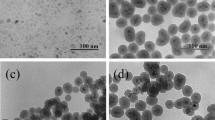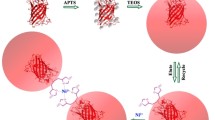Abstract
Silica nanoparticles are most commonly modified with amino-silanes, followed by post-modification activation for protein immobilization. In this work, epoxy-functionalized silica nanoparticles were prepared by modification with glycidyloxypropyl trimethoxysilane (GPTMS) for direct protein immobilization. Silica nanoparticles possessed an average size of 46 nm, but increased to 63 nm after GPTMS modification. Reaction time, reaction temperature and GPTMS content had no significant effect on particle size. Zeta potential of SiO2 changed from −26mV to +38mV after modification. Fourier-transformed infrared spectroscopy revealed alkyl C-H bending and stretching bands at 2944 cm−1, 1343 cm−1 and 1465 cm−1, respectively, for the modified nanoparticles. Fluorescein cadaverine was found to bind to GPTMS-modified SiO2, but not to bare SiO2, indicating the chemical reactivity of epoxy groups on the modified nanoparticle with amines. Finally, fluorescently labeled bovine serum albumin (BSA) was used as a model protein to investigate the capacity of epoxy-SiO2 nanoparticles for protein immobilization. The results showed that more proteins were immobilized on the particle with longer reaction time, higher NaCl concentration, lower pH, and less GPTMS content. More importantly, proteins bound to epoxy-SiO2 nanoparticle were highly stable. Under optimized reaction conditions, as much as 25 mg BSA/g nanoparticle was covalently attached to the nanoparticle. The epoxy silane modification of silica nanoparticles offers a reactive surface for one-step and high-density protein immobilization.
Similar content being viewed by others
References
Gleiter H. Deformation of polycrystals: Mechanism and Microstructures. Roskilde: Riso Nat. Lab. 1981, 15.
Patolsky F, Zheng G, Lieber C M. Nanowire sensors for medicine and the life sciences. Nanomedicine-UK, 2006, 1: 51–56.
Liu Y Y, Miyoshi H, Nakamura M. Nanomedicine for drug delivery and imaging: A promising avenue for cancer therapy and diagnosis using targeted functional nanoparticles. Int J Cancer, 2007, 120: 2527–2537.
Tallury P, Payton K, Santra S. Silica-based multimodal/multifunctional nanoparticles for bioimaging and biosensing applications. Nanomedicine-UK, 2008, 3: 579–592.
Liang X J, Chen C Y, Zhao Y L, et al. Biopharmaceutics and therapeutic potential of engineered nanomaterials. Curr Drug Metab, 2008, 9: 697–709.
Xu Y, Li Q G. Multiple fluorescent labeling of silica nanoparticles with lanthanide chelates for highly sensitive time-resolved Immunofluorometric assays. Clin Chem, 2007, 53: 1503–1510.
Gao D M, Wang, Z Y, Liu, B H, et al. Resonance energy transfer-amplifying fluorescence quenching at the surface of silica nanoparticles toward ultrasensitive detection of TNT. Anal Chem, 2008, 80: 8545–8553.
Liu G D, Lin Y H. Nanomaterial labels in electrochemical immunosensors and immunoassays. Talanta, 2007, 74: 308–317.
Hun X, Zhang Z J. Fluoroimmunoassay for tumor necrosis factoralpha in human serum using Ru(bpy)3Cl2-doped fluorescent silica nanoparticles as labels. Talanta, 2007, 73: 366–371.
Yan J L, Estevez M C, Tan W H, et al. Dye-doped nanoparticles for bioanalysis. Nano Today, 2007, 2: 44–50.
Chang Z, Zhou J M, Zhao K, et al. Ru(bpy)3 2+-doped silica nanoparticle DNA probe for the electrogenerated chemiluminescence detection of DNA hybridization. Electrochim Acta, 2006, 52: 575–580.
Wei H, Wang E. Electrochemiluminescence-based DNA detection using guanine oxidation at electrostatic self-assembly of Ru(bpy)3 2+-doped silica nanoparticles on indium tin oxide electrode. Chem Lett, 2007, 36: 210–211.
Wang X Y, Yun W, Zhou J M, et al. Ru(bpy)3 2+-doped silica nanoparticle aptasensor for detection of thrombin based on electrogenerated chemiluminescence. Chinese J Chem, 2008, 26: 315–320.
Burns A, Ow H, Wiesner U. Fluorescent core-shell silica nanoparticles: towards “Lab on a Particle” architectures for nanobiotechnology. Chem Soc Rev, 2006, 35: 1028–1042.
Lu H C, Yi G S, Zhao S Y, et al. Synthesis and characterization of multi-functional nanoparticles possessing magnetic, up-conversion fluorescence and bio-affinity properties. J Mater Chem, 2004, 14: 1336–1341.
Liu W, Zhong W, Du Y W. Magnetic nanoparticles with core/shell structures. J Nanosci Nanotech, 2008, 8: 2781–2792.
Nobs L, Buchegger F, Gurny R, Allemann E. Current methods for attaching targeting ligands to liposomes and nanoparticles. J Pharm Sci-US, 2004, 93: 1980–1992.
Vandenberg E, Elwing H, Askendal A, et al. Protein immobilization to 3-aminopropyl triethoxy silane/glutaradehyde surface: characterization by detergent washing. J Colloid Interf Sci, 1991, 143: 327–335.
Howarter J A, Youngblood J P. Optimization of silica silanization by 3-aminopropyltriethoxysilane. Langmuir, 2006, 22: 11142–11147.
Liu S, Zhang H L, Liu T C, et al. Optimization of the methods for introduction of amine groups onto the silica nanoparticle surface. J Biomed Mater Res A, 2006, 80A: 752–757.
An Y Q, Chen M, Xue Q J, et al. Preparation and self-assembly of carboxylic acid-functionalized silica. J Colloid Interf Sci, 2007, 311: 507–513.
Plueddemann E P. Silane Coupling Agents. 2nd Edition. New York: Plenum Press, 1991, p118.
Shi D L. Introduction to Biomaterials. 1st Edition. 13. Polymer Matrix Composite Biomaterials. New Jersey: World Scientific Publishing Co, 2006, p198.
Zhang Q, Guo L H. Multiple labeling of antibodies with dye/DNA conjugate for sensitivity improvement in fluorescence immunoassay. Bioconjugate Chem, 2007, 18: 1668–1672.
Qhobosheane M, Santra S, Zhang P, et al. Biochemically functionalized silica nanoparticles. Analyst, 2001, 126: 1274–1278.
Bagwe R P, Yang C Y, Hilliard L R, et al. Optimization of dye-doped silica nanoparticles prepared using a reverse microemulsion method. Langmuir, 2004, 20: 8336–8342.
Luzinov I, Julthongpiput D, Liebmann-Vinson A, et al. Epoxy-terminated self-assembled monolayers: molecular glues for polymer layers. Langmuir, 2000, 16: 504–516.
Fisher M L, Colic M, Rao M P, et al. Effect of silica nanoparticle size on the stability of alumina/silica suspensions. J Am Ceram Soc, 2001, 84: 713–718.
Lee D, Gemici Z, Rubner M F, et al. Multilayers of oppositely charged SiO2 nanoparticles: effect of surface charge on multilayer assembly. Langmuir, 2007, 23: 8833–8837.
Tarducci C, Kinmond E J, Badyal J P S. Epoxide-functionalized solid surfaces. Chem Mater, 2000, 12: 1884–1889.
Schottner G. Hybrid sol-gel-derived polymers: applications of multifunctional materials. Chem Mater, 2001, 13: 3422–3435.
Alonso B, Massiot D, Babonneau F, et al. Structure control in germania hybrid organic-inorganic materials. Chem Mater, 2005, 17: 3172–3180.
Wanunu M, Livne S, Vaskevich A, et al. Assembly of coordination nanostructures via ligand derivatization of oxide surfaces. Langmuir, 2006, 22: 2130–2135.
Chen W F, Kuo P L. Covalently cross-linked perfluorosulfonated membranes with polysiloxane framework. Macromolecules, 2007, 40: 1987–1994.
Wheatley J B, Schmidt D E. Salt induced immobilization of proteins on a high-performance liquid chromatographic epoxide affinity support. J Chromatogr A, 1993, 644: 11–16.
Wheatley J B, Schmidt D E. Salt induced immobilization of affinity ligands onto epoxide-activated supports. J Chromatogr A, 1999, 849: 1–12.
Author information
Authors and Affiliations
Corresponding author
Additional information
Supported by the National Basic Research Program of China (Grant No. 2006CB403303) and the National Natural Science Foundation of China (Grant Nos. 20621703, and 20825519 )
About this article
Cite this article
Zhang, Q., Huang, R. & Guo, LH. One-step and high-density protein immobilization on epoxysilane-modified silica nanoparticles. Chin. Sci. Bull. 54, 2620–2626 (2009). https://doi.org/10.1007/s11434-009-0210-7
Received:
Accepted:
Published:
Issue Date:
DOI: https://doi.org/10.1007/s11434-009-0210-7




